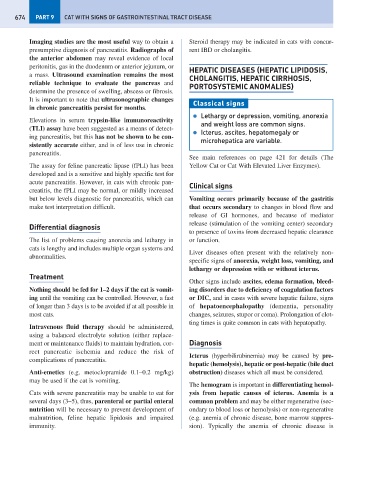Page 682 - Problem-Based Feline Medicine
P. 682
674 PART 9 CAT WITH SIGNS OF GASTROINTESTINAL TRACT DISEASE
Imaging studies are the most useful way to obtain a Steroid therapy may be indicated in cats with concur-
presumptive diagnosis of pancreatitis. Radiographs of rent IBD or cholangitis.
the anterior abdomen may reveal evidence of local
peritonitis, gas in the duodenum or anterior jejunum, or HEPATIC DISEASES (HEPATIC LIPIDOSIS,
a mass. Ultrasound examination remains the most CHOLANGITIS, HEPATIC CIRRHOSIS,
reliable technique to evaluate the pancreas and PORTOSYSTEMIC ANOMALIES)
determine the presence of swelling, abscess or fibrosis.
It is important to note that ultrasonographic changes Classical signs
in chronic pancreatitis persist for months.
● Lethargy or depression, vomiting, anorexia
Elevations in serum trypsin-like immunoreactivity and weight loss are common signs.
(TLI) assay have been suggested as a means of detect-
● Icterus, ascites, hepatomegaly or
ing pancreatitis, but this has not be shown to be con- microhepatica are variable.
sistently accurate either, and is of less use in chronic
pancreatitis.
See main references on page 421 for details (The
The assay for feline pancreatic lipase (fPLI) has been Yellow Cat or Cat With Elevated Liver Enzymes).
developed and is a sensitive and highly specific test for
acute pancreatitis. However, in cats with chronic pan- Clinical signs
creatitis, the fPLI may be normal, or mildly increased
but below levels diagnostic for pancreatitis, which can Vomiting occurs primarily because of the gastritis
make test interpretation difficult. that occurs secondary to changes in blood flow and
release of GI hormones, and because of mediator
release (stimulation of the vomiting center) secondary
Differential diagnosis
to presence of toxins from decreased hepatic clearance
The list of problems causing anorexia and lethargy in or function.
cats is lengthy and includes multiple organ systems and
Liver diseases often present with the relatively non-
abnormalities.
specific signs of anorexia, weight loss, vomiting, and
lethargy or depression with or without icterus.
Treatment
Other signs include ascites, edema formation, bleed-
Nothing should be fed for 1–2 days if the cat is vomit- ing disorders due to deficiency of coagulation factors
ing until the vomiting can be controlled. However, a fast or DIC, and in cases with severe hepatic failure, signs
of longer than 3 days is to be avoided if at all possible in of hepatoencephalopathy (dementia, personality
most cats. changes, seizures, stupor or coma). Prolongation of clot-
ting times is quite common in cats with hepatopathy.
Intravenous fluid therapy should be administered,
using a balanced electrolyte solution (either replace-
ment or maintenance fluids) to maintain hydration, cor- Diagnosis
rect pancreatic ischemia and reduce the risk of
Icterus (hyperbilirubinemia) may be caused by pre-
complications of pancreatitis.
hepatic (hemolysis), hepatic or post-hepatic (bile duct
Anti-emetics (e.g. metoclopramide 0.1–0.2 mg/kg) obstruction) diseases which all must be considered.
may be used if the cat is vomiting.
The hemogram is important in differentiating hemol-
Cats with severe pancreatitis may be unable to eat for ysis from hepatic causes of icterus. Anemia is a
several days (3–5), thus, parenteral or partial enteral common problem and may be either regenerative (sec-
nutrition will be necessary to prevent development of ondary to blood loss or hemolysis) or non-regenerative
malnutrition, feline hepatic lipidosis and impaired (e.g. anemia of chronic disease, bone marrow suppres-
immunity. sion). Typically the anemia of chronic disease is

